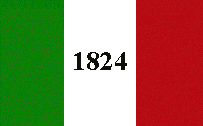



For some years the 1824 flag has floated over many camp sites and ceremonies. It has waved from the top of the Alamo and across endless movie screens. It has become such an icon of Texas history that few people ever stop to consider the true story of the flag. This article is a documentation of my research into the 1824 tri-color. It is not the final word on the subject, as I doubt that we will ever reach the point of empirical certainty. It can, however, be a starting point for the reader's own research into the subject and into different aspects of history in general, which I heartily encourage.
The general public has often heard the tale of how the early Texas colonists revolted against the Mexican dictator Santa Anna and how they were fighting for the restoration of the liberal Mexican Constitution of 1824. To symbolize this they took as one of their banners the Mexican green, white and red tri-color with the black numerals 1 8 2 4 replacing the central Mexican eagle. Most stories recount how this banner flew over the Alamo during the battle which resulted in the massacre of Travis, Bowie, Crockett, Dickenson and the 180 odd other defenders of that fortress.
As usual, the true story is not quite so simple and certainly not nearly so neat. There are things we know as facts. There are also things we may logically deduce. There are some parts of the story that are misinterpretations of previous writings and there are parts of the story that are pure mythology. Texians and Hollywood seldom allow facts to get in the way of a good story and sometimes these stories take on the guise of history.
Several banners in use at the time serve as starting points for research into this subject. The first of these is the Mexican tri-color, itself. We are not so much concerned with the symbolism of the flag as we are its history. Since declaring its independence from Spain in 1821, there have been only two flag designs for the United States of Mexico. The first Mexican tri-color flag had a white, green, and red fields that ran diagonally across the flag. In each field was a gold star. This flag is referred to as "La Bandera de los Tres Garantias" or the Flag of the Three Guarantees. This flag was used from 1821 until 1824 at which time Agustín de Iturbide was deposed as Emperor of Mexico and the liberal Constitution of 1824 was implemented.
The Federal flag of the United States of Mexico that was adopted in 1824 is substantially the same flag that is in use today by that country. This flag consists of green, white and red vertical fields of equal size. In the center of the white field is an eagle perched on a cactus with a snake in its mouth. With only minor modifications in the design of the eagle motif, this flag has been the National Flag of Mexico since 1824 and was the banner in use during the Texas Revolution.
During the first few months of the Revolution, many of the Texian leaders were simply trying to lend their part in the larger Federalist Revolution that was being waged against the Centralist Regime of Santa Anna in other parts of Mexico. The first reference to a banner resembling the 1824 Flag is one which appears in a letter from Philip Dimmit, commanding the garrison at Goliad, to General Stephen F. Austin, Commander in Chief of the Army of the People, dated October 27th 1835. Dimmit writes:
Later, Philip Dimmit left Goliad to take part in the Storming of Bexar in late 1835. I think we can safely assume that he had his "Constitution of 1824" flag with him. Even during the Storming of Bexar, Dimmit was an ardent supporter of Restoration.
The next reference to an 1824 Flag can be found in the proceedings of the General Council of the Provisional Government of Texas. I believe that from the Dimmit design, evolved the design that was adopted by this General Council for the banner which was to be flown by ships bearing "Letters of Marque and Reprisal". These were privately owned and operated ships that were granted permission by the government to attack and seize enemy ships and cargo. In return for this license the government received a percentage of the value of the seized property. On November 29, 1835 the General Council passed an ordinance which reads in part:
According to this description, there are several designs possible for the privateer flag . The description does not specifically eliminate the eagle motif from the Mexican flag and according to the description, the numerals could have been placed above or below the eagle or could have replaced the eagle altogether. It is very clear that early in the Revolution there were several possible designs for an ensign that signified the desire to restore the Mexican Constitution of 1824, however no original examples of these banners exist today.
In addition, these variations were not limited to the contemporaries of the revolution. When H. A. McArdle was researching his painting "Dawn at the Alamo", which now hangs in the Texas Legislature, he did extensive research into all details of the era. In his preliminary sketch of the flag , the numerals are a gold or yellow color. His notes do not reveal where he obtained the information that the numerals were gold and the rendering of the numerals in gold may have simply been artistic license. In the original ordinance, however, no specific numeral color was mentioned. I suppose it would be equally accurate to color the numerals blue. In still another variation, in McArdle's final painting the numerals are in black and written vertically on the white bar.
Shortly after the Storming of Bexar, Phillip Dimmit was one of those who changed their mind about reconciling with Mexico and by the time he left for Goliad in early December, 1835, he was firmly for an independent Texas. We do not know whether he left his original flag in Bexar or took it with him to Goliad. We do know that shortly after Dimmit left Bexar, Dr. James Grant and Col. F.W. Johnson who were in Bexar at the time, started using an 1824 flag. Did Dimmit give his flag to Grant and Johnson? Probably not. The animosity between Grant and Dimmit was well known and usually quite evident. Dimmit may have abandoned the flag in Bexar to be usurped by Grant or he may have destroyed the flag on his way to Goliad. Whichever took place, by the time he reestablished his commandancy of Goliad he had abandoned the 1824 Flag and was using a white flag with a bloody arm holding a sword as his banner . This banner was adopted to celebrate the signing of an unsanctioned Declaration of Independence at Goliad on December 20, 1835. Much to the chagrin of the plodding Texas provisional government, the colonists were beginning to adopt a much more militant stance toward the established Mexican government.
There is some indication that Dimmit may have left his original 1824 flag in Bexar and that when Dr. James Grant stripped the Alamo of provisions and left Bexar on January 1, 1836, he took the flag with him. Grant, though a citizen of Coahuila, was one of the few Texian leaders who continued to fight for Restoration. Grant held large land holdings in Coahuila and the only way he could keep these large estates was for the 1824 Constitution to be restored. If either Santa Anna won the war or the Texians won independence from Mexico, his very large land holdings in Coahuila would be lost forever. The only way he could keep his land would be for Santa Anna to be deposed and the Constitution of 1824 to be reinstated. To this end he stripped the Alamo of all provisions and mounted an expedition to Matamoros in an abortive attempt to link up with and rally Mexican Federalist forces there. On January 10, 1836, Col. F.W. Johnson, who helped lead the Matamoros Expedition, issued a proclamation which said in part:
Apparently, Johnson appropriated the 1824 Flag from the privateers, placed it at the head of his volunteers and attributed the action to the General Council. The General Council never santioned the flag for anything except Letters of Marque and Reprisal. This detail does not seem to have been noticed either by Johnson or a great many other people since that time.
The Matamoros Expedition made it as far as San Patricio where on February 27 General Urréa, of the Mexican Army, and his men captured or killed most of the expedition members. Johnson and three others managed to escape the Mexican's attack. Johnson, disgusted with the personalities and politics of the revolution, retired from the army and later wrote a history of Texas. When the Mexicans attacked San Patricio, Grant was away hunting horses and when the Mexicans caught up with him on March 2 he was killed at the Battle of Agua Dulce Crossing.
It is ironic that on the very same day, March 2, 1836, both reasons for the 1824 Flag died. Dr. James Grant, the only man in Texas still fighting for the restoration of the Constitution of 1824, was killed at Agua Dulce Crossing and the Texian convention at Washington-on-the-Brazos passed the Texas Declaration of Independence.
The question still remains, however, "Did the 1824 Flag fly during
the
Battle of the Alamo?" Probably not, but that is a story for
the next chapter
.
Austin, Stephen F. The Austin Papers. Compiled and edited by Eugene C. Barker. 3 vols. Washington, D.C., and Austin: American Historical Association and University of Texas, 1919-1926.
Gammel, Hans Peter Nielson, compiler The Laws of Texas, 1822-1897 . 10 vols. Austin: Gammel Book Co. , 1898.
Historia y Leyenda del Escudo y la Bandera de Mexico, Dirrecion General de Asuntos Culturales, Tamaulipas, 1982.
Johnson, Frank W. A History of Texas and Texans. 5 vols. Edited by Eugene C. Barker. Chicago and New York: American Historical Association, 1914.
McArdle, Harry Arthur, Alamo Notebook, unpublished, Texas State Archives
Spain, Charles A., Jr. Flags and Seals of Texas, South Texas Law Review vol. 33 no. 1, February 1992
Walraven, Bill and Marjorie K. The Magnificent Barbarians.
Austin,
Eakin Press, 1993.